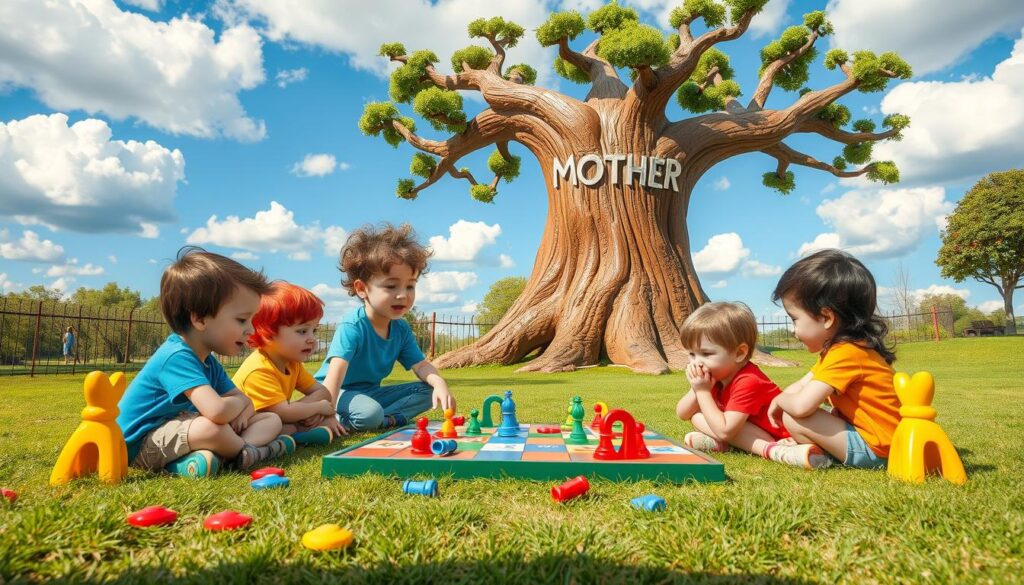As we delve into the world of traditional outdoor games, we find ourselves at the intersection of nostalgia and modernity with the game of Mother May I. The evolution of the game has been remarkable, particularly as we approach Mother May I 2024. This beloved childhood pastime has not only survived the test of time but has also adapted to incorporate contemporary elements that resonate with today’s culture.
In this exploration, we will uncover how Mother May I has transformed over the years, reflecting shifting societal dynamics while remaining a thrilling outdoor game for families and friends. Together, we will appreciate the significance of its journey, learning about its history, and understanding its current relevance in our lives. Join us as we unfold the layers of this engaging play and celebrate its timeless appeal.
Introduction to Mother May I
The mother may I game stands as a timeless example of classic children’s games, engaging youngsters for generations. This game exemplifies the joy of outdoor play, capturing children’s imaginations while promoting physical activity and social interaction.
In a typical setting, players designate one individual as the “mother” or “father,” who controls the pace of the game. Participants take turns asking for permission to move in various ways, offering a playful twist on the concept of seeking approval. Players might suggest actions such as taking strides forward or engaging in amusing movements like crabwalking.
This dynamic fosters essential skills in communication, listening, and teamwork. As children navigate through the game, they also tackle the challenge of responding to feedback from the adult figure, which enhances their adaptability and decision-making.
The lasting appeal of the mother may I game demonstrates its integral role in developing not just physical coordination, but also valuable social skills. By maintaining this playful structure, we ensure that outdoor play remains a cherished part of childhood experiences.
The Origins of Mother May I
The origins of mother may I trace back through the rich history of games, revealing a tapestry of childhood play that spans generations. Many traditional children’s games have influenced its development, showcasing the evolution of societal values and children’s games history. As we explore this game’s roots, we uncover its ties to cultural contexts and the educational philosophies that have shaped how children engage in play.
Across various cultures, games like mother may I have emerged as a way for children to express creativity and learn important social skills. These interactions reflect changing views on childhood and the importance of play in development. For instance, the encouragement of imagination in the game mirrors the growing understanding of the role play has in cognitive and emotional growth.
Moreover, variations of the game have appeared throughout history, each adapting to the needs and preferences of children in different settings. This adaptation demonstrates how, over time, the origins of mother may i have changed, making it relevant to new generations while still holding onto its core elements of fun and playful interaction.
As we delve into this fascinating history, we recognize that the evolution of mother may I is not just a story of a game, but a reflection of our changing society, values, and the timeless joy of childhood play.
Mother May I 2024: What’s New?
As we step into 2024, exciting developments have transformed the classic game of Mother May I. In our journey to enhance play experiences for everyone, we have introduced innovative updates and variations that foster inclusion and engagement. These changes reflect our commitment to maintaining the essence of the game while adapting to modern sensibilities.
Updated Rules for Modern Play
The updated game rules in mother may i 2024 aim to streamline gameplay and enhance enjoyment for players of all ages. Key updates include:
- Clearer instructions for young players, making it easier to understand the mechanics.
- A new scoring system that encourages friendly competition while promoting teamwork.
- Flexible movement options allowing for various interpretations of “permissions,” leading to organically evolving game dynamics.
Inclusive Variations in Gameplay
Recognizing the importance of community building, we have developed inclusive gameplay variations within mother may i 2024. These enhancements encourage participation from a diverse range of players:
- Adjustable team sizes, accommodating small and large groups.
- Alternative roles that let everyone contribute creatively, whether as “Mother,” “Players,” or “Judges.”
- Customizable prompts promoting storytelling and imagination, which captivate younger players and seasoned veterans alike.
Overall, the innovations introduced into mother may i 2024 embrace a contemporary audience while respecting the game’s heritage, making it accessible and enjoyable for all.

Understanding Mother May I Rules
We dive into the mother may i rules to fully appreciate this engaging children’s game. The fundamental premise is straightforward: players, referred to as “children,” seek permission from the “Mother,” who governs the movement commands. This structure sets the tone for both fun and a learning environment, encouraging essential social skills.
The game mechanics are pivotal for understanding how to participate effectively. Each player takes turns asking, “Mother, may I?” followed by a specific movement. The Mother gives permission by stating “Yes, you may,” or denying it through “No, you may not.” This interaction fosters listening comprehension, patience, and respect—core aspects of the children’s game rules.
Movement options range widely and can include bunny hops, frog hops, and even unique steps like scissors hops or banana steps. Such diversity not only keeps the game exciting but also promotes creativity and physical coordination. Each turn provides a valuable lesson in communication; players must articulate their requests clearly and respectfully.
Inclusivity remains an essential component of the game’s framework. We recommend using gender-neutral language and offering various step options to cater to diverse participants. Understanding cultural differences and modifying tasks for neurodiverse players ensures everyone can join in on the fun.
Finally, a table below summarizes key elements of the game mechanics and rules for quick reference:
| Aspect | Details |
|---|---|
| Age Range | 3 years and older |
| Movement Types | Bunny hops, frog hops, scissors steps |
| Skills Developed | Communication, patience, listening |
| Inclusivity Tips | Use neutral language, consider modifications |
| Equipment Needed | None |
| Popular Variations | Father May I, Captain May I |
Mother May I Variations Across Regions
Exploring the various mother may I variations reveals how this beloved game has transformed across different regions. These adaptations often reflect local customs and influences, resulting in unique gameplay dynamics. Additionally, by recognizing the cultural game variations, we can appreciate the diverse interactions and experiences that players encounter.
Regional Differences and Their Impacts
The game thrives in a multitude of forms depending on the region, showcasing particular rules and gameplay adaptations. Some specific variations such as Giant Steps, popular on the northeast coast of the USA, significantly alter player engagement. With three or more players involved, one takes the role of the “mother” or “leader,” while others request permission to advance towards the finish line.
- Fancy Steps: Involves creative movements, such as the Umbrella Step, where players spin while attempting to maintain control.
- New Steps Only: Mandates players to invent and execute a new move each time, fostering silliness and creativity.
- Backward May I: A twist on the original, as players must walk backward towards the leader, presenting new challenges.
These regional differences enhance the overall player experience and contribute to social development by encouraging teamwork, fair play, and communication. The game supports the development of essential skills, including coordination, balance, and listening abilities, as well as enhancing short-term memory through command recollection.
Furthermore, the versatility of mother may I allows it to adapt well to various settings, making it suitable for family gatherings, school events, and sports training. By incorporating creative obstacles and trivia, the game can engage participants of all ages, showcasing its educational values while maintaining a fun atmosphere.

Mother May I Instructions for New Players
Learning the game of Mother May I can be an exciting experience, especially for new players. This beginner’s guide offers essential mother may i instructions to help you get started with ease. We can break down the gameplay into steps, making it accessible to everyone.

To join in the fun, ensure you have at least two players. Having a larger group can enhance the excitement, but it’s not required. Here are the basic steps we can follow:
- Select a Leader: One player becomes “Mother.” The rest of the players stand at a distance—ideally at least 20 feet away.
- Request Moves: Participants take turns asking, “Mother may I?” to make specific movements towards the leader. The leader can respond with “Yes, you may” or offer alternative instructions.
- Move Forward: Players who receive permission may advance using various movement patterns, such as walking or hopping. There are five variations in the instructions to keep things interesting.
- Goal: The first player to reach “Mother” and receive five checks wins the game and transitions into a coaching role.
- Leading Role: Once players reach the leader, they help coach any remaining players to finish the game.
As we begin this journey of learning the game, keep in mind the social aspects of play. Many children may have fond memories of playing Mother May I outdoors, often along streets or in playgrounds. It’s a great way to develop gross motor skills and foster creativity with movements.
New players should not worry about memorizing every single rule at once. Many enjoy learning the instructions as they play. Over time, kids may invent new movement patterns and develop their skills, making each game unique.
Additionally, parents often share mother may i instructions with children, encouraging them to pass on the game. This generational transfer enriches the experience and keeps the spirit of Mother May I alive for future players.
With enthusiasm and a bit of practice, everyone can enjoy the thrills of Mother May I. It’s easy to forget to say “Mother May I?” but that’s part of the fun. Challenge each other and embrace the learning experience!
Strategizing Your Play: Mother May I Tips
Engaging in the game of Mother May I offers more than just entertainment; it provides valuable lessons about permission and boundaries. By implementing effective strategies, both “Mother” and the players can enhance their gameplay experience. Here, we share essential gaming tips and winning strategies that can boost our chances of success while maintaining the spirit of fun.
Effective Strategies for Winning
Our journey through this game reveals that strategic thinking plays a pivotal role in securing victory. Here are some key mother may i strategies that can elevate our performance:
- Understand the Role of “Mother”: The “Mother” must grant permission based on player requests. Establishing clear guidelines for what types and sizes of steps are acceptable can create excitement while maintaining fairness.
- Anticipate Player Moves: Players should consider their requested steps carefully. Asking for “three giant steps” can quickly get them closer to victory while balancing their need for caution.
- Set Boundaries: As with communication in life, it’s important to recognize when to pause. We can implement a personal strategy of refraining from engaging in competitive requests during certain times, mirroring our own communication boundaries.
- Encourage Team Play: Turning the game into a team experience fosters collaboration and camaraderie. By dividing players into teams, we can add a new layer of strategy and make the game more dynamic.
- Vary the Game for Themed Events: Personalizing the authoritative figure’s name, based on an event theme, can add excitement. For example, calling the “Mother” “Captain” during a pirate-themed party can engage players even further.
As we embrace these gaming tips, we find that the thrill of the game increases with the number of participants. More players not only expand the possibilities for creative step requests but also inject an element of unpredictability.

The beauty of Mother May I lies in its balance of competition and education. It’s a platform for young children, typically ages four to nine, to learn about asking for permission and the importance of boundaries in a playful environment. By integrating these strategies, not only can we enhance our gameplay, but we also impart essential life lessons, promoting good manners and respect for others.
| Strategy | Description |
|---|---|
| Understand the Role of “Mother” | Clearly defines what requests can be permitted, ensuring fair play. |
| Anticipate Player Moves | Encourages players to think ahead and request strategically. |
| Set Boundaries | Reflects the importance of knowing when to engage or hold back. |
| Encourage Team Play | Promotes collaboration among participants for greater enjoyment. |
| Vary the Game for Themed Events | Adds novelty to the game by adapting roles based on themes. |
Embracing Mother May I as an Outdoor Game
Playing the mother may I outdoor game presents an ideal way for children to engage in outdoor activities while fostering important skills. We recognize numerous benefits that come from promoting such games among kids. Research suggests that a significant 75% of children involved in outdoor games display improved gross motor skills, coordination, and strength. This transformation enhances physical fitness and encourages an active lifestyle.
Outdoor play is a vital component of childhood, encouraging kids to play in nature. The imaginative aspects of games like Mother May I stimulate creativity, with 80% of children expressing newfound imaginative thinking. Such engagement is not just playful; it builds problem-solving abilities that 85% of youngsters who play outdoors exhibit.
Additionally, participating in the mother may I outdoor game significantly improves children’s social skills. Approximately 70% of players develop crucial abilities in taking turns, sharing, and working cooperatively in teams. We can promote better emotional well-being too, as 60% of children experience reduced stress thanks to time spent outdoors.
Setting up the game in ideal outdoor environments enhances its benefits. Consider these tips for facilitating the mother may I outdoor game:
- Choose spacious, safe areas where children can run freely.
- Create clear boundaries for game play to maintain order.
- Encourage teamwork and interaction among players.
- Incorporate elements of nature, such as trees or open fields, for a more immersive experience.
The joy of playing together in a vibrant, natural setting promotes overall health and reduces screen time by an impressive 50%. Embracing Mother May I as an outdoor game not only nurtures physical health but also supports mental and emotional resilience, making it a fantastic activity for family and friends alike.
Conclusion
In reflecting on the journey of Mother May I, we recognize its profound evolution from a traditional childhood game to a staple of outdoor play in 2024. Understanding this game evolution enriches our appreciation for its enduring appeal and adaptability, showcasing how it continues to engage new generations. With updated rules and inclusive variations, we see a game that not only offers fun but also fosters community among players of all ages.
The importance of outdoor play has never been clearer, especially as we strive to connect with one another in today’s digital age. Engaging in activities like Mother May I allows us to step outside, breathe fresh air, and create lasting memories without the confines of technology. These shared experiences strengthen our bonds and emphasize the value of play in our lives.
As we wrap up our exploration, our final thoughts encourage you to embrace the charm and simplicity of Mother May I 2024. Whether introducing it to newcomers or rediscovering the joy it brings, let’s celebrate this game that has not only stood the test of time but continues to evolve and inspire new moments of connection and laughter among us.